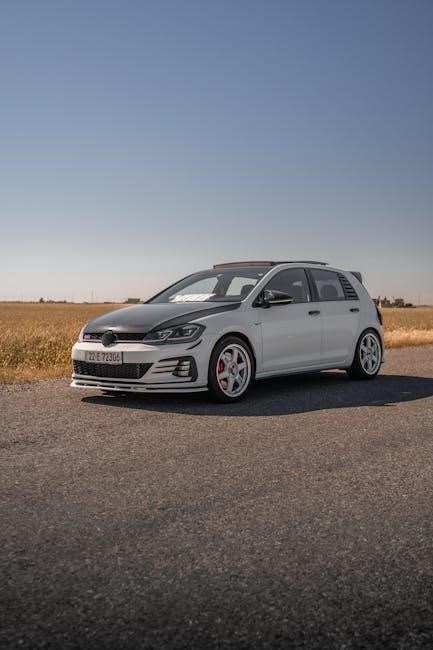Golf R DSG vs․ Manual: A Comprehensive Comparison
This comparison analyzes the Golf R’s manual and DSG transmissions․ We will weigh performance, reliability, driving experience, fuel economy, and maintenance․ The goal is to help you choose the best fit․

The Volkswagen Golf R presents a compelling choice in the hot hatch market․ But, deciding between the manual and DSG transmissions can be challenging․ Many sources debate the merits of each․ The manual offers a traditional, engaging experience, while the DSG provides quicker shifts and enhanced performance․ Some argue for “saving the manual,” emphasizing driver involvement․ Others prioritize the DSG’s speed and efficiency, especially in daily driving situations․ This comparison delves into the nuances of both options․ We will consider factors beyond mere acceleration figures․ We will explore driver engagement, reliability, and long-term ownership․ Ultimately, the “better” choice depends on individual preferences and priorities․ Consider your driving style, daily needs, and performance aspirations․ This comprehensive comparison will empower you to make an informed decision․

Performance
This section dissects the raw performance of the Golf R with both transmissions․ We’ll analyze acceleration, in-gear responsiveness, and track capabilities․ Objective data and subjective driver impressions will be considered․
Acceleration and Speed: 0-60 and Beyond
The DSG transmission in the Golf R offers quicker acceleration times compared to the manual․ Expect almost a second difference in 0-60 mph sprints, making the DSG the faster choice off the line․ Launch control further enhances the DSG’s advantage, ensuring optimal starts․
However, beyond the initial burst, the manual transmission can offer a more engaging experience․ While the DSG provides rapid shifts, the manual allows for greater control over gear selection and power delivery․
Ultimately, the DSG excels in outright speed, while the manual caters to drivers who prioritize involvement․ Consider your driving style and preferences when deciding which transmission best suits your needs for acceleration and overall speed․
In-Gear Acceleration: 30-100 mph Performance
When evaluating in-gear acceleration, the DSG’s rapid shifts maintain momentum, contributing to quicker times between 30-100 mph․ Its ability to seamlessly transition between gears minimizes power interruption, delivering consistent performance․ The manual transmission, while potentially lighter, relies on driver skill for optimal gear selection․
The manual’s advantage is the driver’s control over the power band, allowing them to exploit the engine’s torque․ However, achieving the same level of speed as the DSG requires precise shifting․ The DSG transmission provides effortless acceleration in this range․
For drivers seeking the fastest possible times, the DSG offers a clear advantage, but drivers who prefer a more involved experience may find the manual rewarding․
Track Performance: Lap Times and Driver Experience
On the track, the DSG transmission in the Golf R often translates to faster lap times due to its rapid and precise gear changes․ The DSG minimizes power loss between shifts, enabling consistent acceleration and optimal performance․ Launch control, a common feature in DSG-equipped models, provides an advantage during starts․
The manual transmission offers a different track experience․ Drivers can engage in a more intimate connection with the car, controlling gear selection and engine braking․ While requiring more skill, a well-executed manual shift can be immensely satisfying․ However, the manual’s lap times are generally slower due to the time spent shifting․
Ultimately, track performance depends on driver skill․ The DSG provides an easier path to faster times, but the manual offers a more engaging experience․

Driving Experience

The driving experience differs significantly between the DSG and manual Golf R․ Consider driver engagement, daily comfort, and suiting your driving style when making your choice․
Driver Engagement and Enjoyment
For enthusiasts, the manual Golf R offers a uniquely engaging experience․ Shifting gears yourself provides a direct connection to the car․ This allows for greater control and involvement in the driving process․ Many drivers find the manual transmission more fun․ Especially when tackling winding roads or enjoying spirited driving․ The satisfaction of perfectly executed shifts and the tactile feedback from the clutch and shifter cannot be replicated by an automatic transmission․
However, the DSG offers its own kind of enjoyment․ The lightning-fast gear changes and seamless acceleration provide a thrilling and efficient driving experience; Some drivers appreciate the ease and precision of the DSG․ Allowing them to focus more on the road and overall driving dynamics․ Ultimately, the level of driver engagement and enjoyment depends on individual preferences․ Some prioritize the raw, hands-on feel of a manual, while others prefer the effortless performance of a DSG․
Daily Driving Comfort and Convenience
In daily driving scenarios, the DSG transmission shines․ Its automatic operation eliminates the need for constant shifting, making commutes and traffic congestion much more manageable․ The DSG’s smooth gear changes and effortless acceleration enhance overall comfort and convenience․ This is particularly beneficial in stop-and-go traffic․ The manual transmission, while engaging, can become tiresome in such situations․
The constant clutch work and gear changes can be physically demanding, especially during long drives․ The DSG’s ease of use makes it a more practical choice for drivers who prioritize comfort and convenience in their daily commutes․ Additionally, features like adaptive cruise control and lane keep assist integrate seamlessly with the DSG․ Further enhancing the driving experience and reducing driver fatigue on long journeys․ For those seeking a relaxed and effortless daily drive, the DSG offers a clear advantage․

Suitability for Different Driving Styles
The choice between DSG and manual depends heavily on individual driving preferences and priorities․ The DSG caters to drivers who value speed, efficiency, and ease of use․ Its rapid gear changes and launch control capabilities make it ideal for those seeking optimal performance․ It also offers a more relaxed experience for everyday commutes․
The manual transmission appeals to drivers who prioritize driver engagement and control․ The tactile feel of the gear lever and the direct connection to the engine offer a more visceral driving experience․ Manual is best suited for those who enjoy the challenge of mastering the car and appreciate the art of driving․ Ultimately, the best choice depends on whether you value convenience and peak performance or driver engagement and a more hands-on experience․

Reliability and Maintenance
This section examines the long-term reliability of both transmissions․ We will cover clutch wear in manuals and DSG servicing needs․ Potential issues unique to each transmission type will also be addressed․
Long-Term Reliability of DSG vs․ Manual
When considering the long-term ownership of a Golf R, a key factor is the reliability of its transmission․ Generally, DSGs are considered robust․ They’re often seen as more reliable than manuals, potentially avoiding catastrophic failures over extended periods․ However, this doesn’t mean they are without their own servicing needs․
Manual transmissions, while simpler in design, are susceptible to clutch wear․ This requires eventual replacement, which is a significant maintenance cost․ DSGs, on the other hand, have complex mechatronics and require scheduled fluid changes․ These services are crucial to maintain optimal performance and prevent potential issues․
Anecdotally, some sources suggest that manual clutches in Golf Rs can struggle with stock power, let alone when modified․ This may lead to premature wear․ Regular maintenance and mindful driving habits can mitigate this risk․ Choosing between a DSG and manual involves weighing the potential failure points and maintenance demands of each․
Clutch Wear and Replacement (Manual)
One of the primary concerns with a manual transmission Golf R is clutch wear․ The lifespan of a clutch depends on various factors․ These include driving style, frequency of aggressive launches, and overall usage conditions․ In general, a performance-oriented car like the Golf R may experience accelerated clutch wear compared to a standard vehicle․
Aggressive driving, such as frequent hard acceleration and clutch slipping, will significantly shorten the clutch’s lifespan․ Symptoms of a worn clutch include slipping during acceleration, difficulty shifting gears, and a high engagement point․ Replacement becomes necessary when these signs become apparent․
Clutch replacement is a notable maintenance expense for manual Golf Rs․ The cost includes both the replacement clutch kit and the labor involved in removing the transmission․ Some owners opt for upgraded clutch kits that can handle increased power output if they plan on modifying their vehicle․ This adds to the initial replacement cost․
DSG Servicing and Potential Issues
The DSG transmission, while offering performance benefits, requires specific servicing to maintain its reliability․ Regular fluid and filter changes are crucial to prevent issues․ These should be performed according to Volkswagen’s recommended service intervals․
Potential problems with the DSG can arise if servicing is neglected․ Issues may include jerky shifting, delayed engagement, or complete failure of the transmission․ Mechatronic unit failures, which control the shifting process, are also a known concern․
Addressing DSG issues can be more expensive than manual transmission repairs․ The complexity of the DSG system necessitates specialized tools and expertise․ Diagnosis and repair often require a qualified technician with experience in dual-clutch transmissions․ Preventative maintenance is key to mitigating the risk of costly repairs․
Some owners report that the DSG is reliable․ It is arguably the best performing twin-clutch transmission․

Modifications and Tuning
Modifying a Golf R opens possibilities․ The transmission’s strength matters when increasing power․ The DSG has torque capacity․ The manual needs clutch upgrades to handle increased power after tuning․
DSG Torque Capacity and Tuning Potential
The Golf R’s DSG transmission is known for its robustness, particularly when considering performance modifications․ A significant advantage lies in its higher torque capacity compared to the stock manual clutch․ This inherent strength makes the DSG a popular choice for enthusiasts looking to tune their Golf R for more power without immediately addressing transmission upgrades․
The DSG can typically handle a substantial increase in torque output from ECU tunes and bolt-on modifications before requiring internal upgrades․ This provides a buffer for owners who plan to gradually increase performance․ However, pushing the limits will eventually require reinforcing the DSG with upgraded clutches and software tuning to optimize shifting behavior and prevent slippage․
Therefore, while the DSG offers a good starting point for tuning, careful consideration and eventual upgrades are essential for maximizing performance and ensuring long-term reliability under increased power levels․
Manual Clutch Upgrades for Increased Power
For Golf R owners who prefer the engagement of a manual transmission, increasing engine power often necessitates upgrading the clutch․ The stock clutch in manual Golf Rs can struggle to handle the increased torque from even moderate engine tuning․ Slipping and premature wear are common issues when power levels exceed the clutch’s original design limits․
Several aftermarket clutch options are available, ranging from organic/Kevlar blends for improved daily drivability to more aggressive ceramic or multi-plate designs for high-horsepower applications․ Choosing the right clutch depends on the intended use and power goals․ A stronger clutch ensures reliable power transfer and prevents slippage under hard acceleration․
However, upgrading the clutch can also affect pedal feel and engagement characteristics․ Some performance clutches may have a heavier pedal or require more precise engagement․ Therefore, selecting a clutch that balances performance with acceptable drivability is crucial for maintaining an enjoyable driving experience․

Cost and Value
Analyzing the cost and value proposition requires considering the initial purchase price difference between DSG and manual․ We must also evaluate the fuel economy, maintenance costs, and the long-term resale value impact․
Purchase Price Difference: DSG vs․ Manual
The initial financial commitment is a significant factor when choosing between a DSG and manual Golf R․ Typically, the DSG variant commands a higher purchase price․ For example, in some markets, the DSG adds around $1,400 to the bottom line․ This premium reflects the more complex engineering and advanced technology of the dual-clutch transmission․

However, prospective buyers should weigh this initial cost against the potential long-term benefits and drawbacks․ Factors like driving preferences, intended use (daily commute versus weekend track days), and anticipated maintenance needs all play a role in determining whether the DSG’s price premium is justified․
Ultimately, the decision hinges on individual priorities and budgetary constraints․ While the manual offers a lower entry point, the DSG provides enhanced performance and convenience, which may outweigh the initial cost for some buyers․
Fuel Economy Considerations
Fuel economy is a practical aspect to consider when comparing the DSG and manual Golf R․ Generally, the DSG transmission tends to offer slightly better fuel efficiency compared to the manual version․ This advantage stems from the DSG’s ability to shift gears more quickly and precisely, optimizing engine performance for fuel conservation․
However, the real-world difference in fuel consumption can vary depending on driving habits and conditions․ Aggressive driving with frequent acceleration and braking can diminish the DSG’s fuel-saving advantage․ Conversely, consistent and smooth driving can maximize the DSG’s efficiency gains․
While the DSG might offer a marginal improvement in fuel economy, it’s essential to consider other factors, such as driving enjoyment and personal preferences, when making your final decision․ The difference in fuel costs is unlikely to be a decisive factor for most buyers․
Resale Value: Impact of Transmission Choice
The transmission choice in a Golf R, whether DSG or manual, can influence its resale value, although the impact may vary over time and across different markets․ Traditionally, manual transmissions held a slight edge in resale value due to their appeal to enthusiasts who prioritize driver engagement․ However, the increasing popularity and performance capabilities of DSG transmissions have narrowed this gap․
In some markets, the DSG might even command a slightly higher resale value, particularly if it is perceived as a more modern and convenient option․ Factors such as the overall condition of the car, mileage, and service history play a more significant role in determining resale value than the transmission type alone․
Ultimately, both DSG and manual Golf Rs hold their value well, but keeping your car in excellent condition is most important․
Choosing between the Golf R’s DSG and manual transmissions depends on personal priorities․ Consider performance, driving style, and long-term ownership goals․ Both offer unique benefits appealing to different drivers․
Summarizing the Pros and Cons of Each Transmission
The DSG transmission in the Golf R offers quicker acceleration and enhanced launch control capabilities, making it faster on the track and in everyday driving scenarios․ Its ease of use in traffic and drive-thrus is a significant advantage for daily commutes․ However, the DSG can feel less engaging for some drivers, diminishing the raw, connected feeling of a traditional manual․
Conversely, the manual transmission provides a more immersive and involved driving experience, appealing to enthusiasts who prioritize driver engagement and control․ While it may be slower in outright acceleration, the manual offers a unique sense of connection with the car․ Potential downsides include increased driver fatigue in heavy traffic and the need for clutch replacements over time․ Ultimately, the choice hinges on individual driving preferences and priorities․
Personal Preferences and Making the Right Choice
Deciding between the Golf R’s DSG and manual transmissions ultimately boils down to personal driving style and priorities․ If you value sheer speed, rapid acceleration, and ease of use in daily driving, the DSG is the clear winner․ Its quicker shifts and launch control provide a performance edge that’s hard to ignore․ The DSG is arguably just better than the manual option, as some reviews stated․
However, if you crave a more connected and engaging driving experience, the manual transmission remains a compelling choice․ It offers a level of driver involvement that the DSG simply cannot replicate․ Consider how you intend to use the car․ If you often encounter heavy traffic, the DSG’s convenience might outweigh the manual’s engagement․ Test drive both versions and weigh the pros and cons to determine which transmission best suits your needs․

No Responses